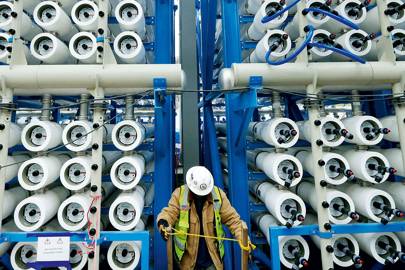The Solution to California's Droughts Could Be Drinking Seawater
Published on by Robert Brears, Founder of Our Future Water, Young Water Leaders, Mitidaption & Author (Springer Nature, Wiley) in Technology
How does California tackle a five-year-long drought? By turning seawater into the kind you can drink.
Carlsbad's 2.2-hectare desalination plant in San Diego County pumps out 200 million litres of water a day, supplying 300,000 residents and businesses. Further north, in Santa Barbara, a second plant will supply 30 per cent of the city's water by early 2017.
The filtration system - a salt ion-removing process known as reverse osmosis - has been developed by IDE Technologies. "Desalination is not new," explains Miriam Faigon, the Israeli firm's COO. "But breakthroughs in membrane manufacturing means reverse osmosis [RO] is popular.
Inside the plant, seawater is pumped into filtration tanks containing anthracite, sand and gravel to remove algae and other particles. It then undergoes a microfiltration process to remove impurities. Next comes reverse osmosis: where water is pushed through membranes of polypropylene to remove bacteria, viruses and dissolved salts.
Reverse osmosis: where water is pushed through membranes of polypropylene to remove bacteria, viruses and dissolved salts.
Carlsbad is owned by desalination developer Poseidon Water. "The largest cost of operating is the electricity needed to push the water through the RO membranes," says Scott Maloni, Poseidon Water's vice president. So it installed 144 energy recovery devices to capture the hydraulic power created by the high-pressure stream of rejected seawater produced during the RO process.
After RO filtration, the water undergoes post-treatment, which includes adding some minerals and disinfection with chlorine. Several centres around the world are now working on advanced membranes that could cut the energy needs of desalination plants even further.
"The real game changer that people are talking about is the graphene membrane," says Maloni. "But nothing suggests that it's anywhere close to commercial availability."
Source: WIRED
Media
Taxonomy
- Water Security
- Drought
- Desalination
- Sustainable Desalination
- Desalination
1 Comment
-
Yes of course. Desalination plants are being built but they are expensive. Actually, wastewater to potable recycling (Direct Potable Reuse) is about half the cost and much more sustainable. Wastewater is 100% recyclable producing biofuel, methane, nutrients and soil conditioners, and of course safe drinking water. DPR water is essentially rainwater and higher quality than most natural waters. There is a barrier to acceptance in some of the public but it is actually the ideal way to go.

